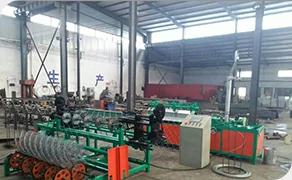 TEL:
+86-13102802206
TEL:
+86-13102802206
 Email:
fencenetting@china.com
Email:
fencenetting@china.com
 Language
Language
 TEL:
+86-13102802206
TEL:
+86-13102802206
 Email:
fencenetting@china.com
Email:
fencenetting@china.com
 Language
Language


Understanding 316 Welding Wire A Comprehensive Guide
Welding is a vital process in various industries, allowing for the joining of metals and ensuring structural integrity. Among the numerous welding materials available, 316 stainless steel welding wire stands out due to its unique properties and applications. This article explores the characteristics, benefits, and implications of using 316 welding wire in various welding processes.
316 stainless steel is an austenitic alloy that consists primarily of iron, with significant additions of chromium, nickel, and molybdenum. The inclusion of molybdenum enhances its resistance to pitting and crevice corrosion, making it particularly well-suited for environments where salt and aggressive chemicals are present. This alloy is widely used in marine applications, chemical processing, and even food processing due to its excellent corrosion resistance and high-temperature performance.
When it comes to welding, 316 welding wire is typically used in Gas Metal Arc Welding (GMAW) and Gas Tungsten Arc Welding (GTAW) processes. The wire comes in different diameters, suitable for various welding applications and positions. Selecting the appropriate diameter is essential for achieving optimal weld penetration and strength. Additionally, the wire is often available in both solid and metal-cored forms, allowing for versatility depending on the welding technique and base materials involved.

One of the standout features of 316 welding wire is its excellent weldability
. The wire is designed to provide low spatter and a smooth arc, resulting in clean and high-quality welds. Moreover, it demonstrates minimal oxidation during the welding process, ensuring that the weld pool remains stable. This is crucial for achieving consistent results, especially in critical applications where structural integrity is paramount.In addition to its mechanical properties, the 316 welding wire is compatible with a variety of filler metals, which allows for effective joining of dissimilar materials. This flexibility is particularly beneficial in construction and fabrication, where different metal types may need to be welded together. The resulting connections not only exhibit high strength but also maintain the corrosion-resistant properties typical of 316 stainless steel.
While there are many advantages to using 316 welding wire, it is important to consider the cost and availability. 316 stainless steel is generally more expensive than other materials, and the welding wire is no exception. However, the durability and longevity of products made with 316 welding wire often justify the initial investment, especially in harsh environments. Over time, the reduced maintenance and replacement costs can lead to overall savings for businesses and manufacturers.
In conclusion, 316 welding wire is a superior choice for those looking to achieve high-performance welding in challenging environments. Its unique composition provides excellent corrosion resistance, good weldability, and versatility, making it an ideal option for a wide range of applications. Whether in the marine industry, chemical processing, or food manufacturing, the use of 316 welding wire ensures strong and reliable welded joints that stand the test of time. As industries continue to advance, the relevance and demand for high-quality welding materials like 316 stainless steel will undoubtedly grow.